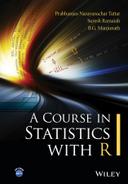Preface
The authors firmly believe that the biggest blasphemy a stat reader can commit is the non-reading of texts which are within her/his mathematical limits. The strength of this attitude is that since mathematical limits are really a perception and consequentially it would be in a decline with persistence, and the reader would then simply enjoy the subject like a dream. We made a humble beginning in our careers and proceeded with reading books within our mathematical limits. Thus, it is without any extra push or pressure that we began the writing of this book. It is also true that we were perfectly happy with the existing books and the purpose of this has not arisen as an attempt to improve on other books. The authors have taken the task of writing this book with a view which is believed to be an empirical way of learning computational statistics. This is also the reason why others write their books and we are not an exception.
The primary reason which motivated us to pick up the challenge of writing this book needs a mention. The Student's t-test has many beautiful theoretical properties. Apart from being a small sample test, it is known to be the Uniformly Most Powerful Unbiased, UMPU, test. A pedagogical way of arriving at this test is a preliminary discussion of hypothesis framework, Type I and II errors, power function, the Neyman-Pearson fundamental lemma which gives the Most Powerful test, and the generalization to the Uniformly Most Powerful test. It is after this flow that we appreciate the t-test as the UMPU test. For a variety of reasons, it is correct for software-driven stat books to skip over these details and illustrate the applications of the t-test. The purpose and intent are met and we have to respect such an approach.
We felt the intrinsic need of a computational illustration of the pedagogical approach and hence our coverage of statistical tests begins from a discussion of hypothesis framework through to the UMPU tests. Similarly, we have provided a demystification of the Iterative Reweighted Least Squares, IRLS, which will provide the reader with a clear view of how to estimate the parameters of the logistic regression. In fact, whenever we have an opportunity for further clarification of the computational aspects, we have taken it up. Thus, the main approach of this book has been to provide the R programs which fill the gap between formulas and output.
On a secondary note, the aim of this book is to provide the students in the Indian subcontinent with a single companion for their Masters Degree in Statistics. We have chosen the topics for the book in a way that the students will find useful in any Semester during their course. Thus, there is more flavor of the Indian subcontinent in this work. Furthermore, as scientific thinking is constant, it can be used by any person on this planet.
We have used R software for this book since it has emerged as one of the powerful statistical software, and each month at least one book appears which uses it as the primary software.
